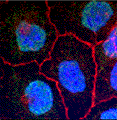Biochemistry, Department of
Document Type
Article
Date of this Version
2007
Abstract
Auxins regulate a complex signal transduction network to direct plant development. Auxin-responsive genes fit into three major classes: the so-called auxin/indole- 3-acetic acid (Aux/IAA), the GH3, and the small auxin-up RNA (SAUR) gene families. The 20-member Arabidopsis thaliana GH3 gene family has been subdivided into three groups. In vitro studies have shown that most Group II members function as IAA–amido synthetases to conjugate amino acids to the plant hormone auxin. Here we report the role of a previously uncharacterized GH3 gene family member, GH3.9, in root growth. Unlike most other Group II family members, GH3.9 expression was repressed by low concentrations of exogenous IAA in seedlings. Transgenic plants harboring a GH3.9 promoter::reporter gene construct indicate that GH3.9 is expressed in the root-hypocotyl junction, leaves and the shoot apical meristem of young seedlings, in mature embryos, and in the root vascular tissue. Expression was also observed in lateral root tips when seedlings were treated with exogenous IAA. Inverse PCR was used to identify an activation tagged T-DNA insertion in chromosome 2 near the 5′UTR region of At2g47750 (GH3.9). Plants homozygous for the T-DNA insertion (gh3.9-1 mutants) had reduced GH3.9 expression, no obvious effects on apical dominance or leaf morphology, greater primary root length, and increased sensitivity to indole- 3-acetic acid (IAA)-mediated root growth inhibition. Additional T-DNA insertion alleles and transgenic plants with reduced GH3.9 transcript levels due to RNA-interference (RNAi) also showed these same phenotypes. Our results provide new information on the function of GH3.9 in roots where it is likely to control auxin activity through amino acid conjugation.



Comments
Published in Planta: An International Journal of Plant Biology 226 (2007), pp.21–34; doi: 10.1007/s00425-006-0462-2 Copyright © 2007 Springer-Verlag. Used by permission.